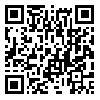
 , H. Ourmazdi
, H. Ourmazdi 
 , A.V. Ehsani Zonooz
, A.V. Ehsani Zonooz 
 , M. Tavalla
, M. Tavalla 
 , KH. Khanaliha
, KH. Khanaliha 
 , SH. Sarvi
, SH. Sarvi 
 , M. Beiromvand
, M. Beiromvand 

Background & Aim: Giardia Lamblia, a flagellate protozoan, is localized to the small bowel where it causes damage to the mucosa with or without gastrointestinal symptoms. In its life cycle this protozoam goes through two stages: trophozoite or active, motile from and resistant or encysted form, by which the infection is transmitted. A number of reports have described some changes in intestinal alkaline phosphatase in rats infected with giardia. Therefore, we planned to evaluate the level of serum IALP(intestinal alkaline phosphatase) in humans infected with giardia via electrophoresis.
Patients and Method: In this descriptive cross-sectional study, we examined a group of 67 patients infected with giardia as the case group and also a group of 30 normal humans with no giardiasis as the control group. Both groups underwent the following tests: fecal examinations including direct smear and formol-detergent, GPT(glutamic-pyruvic transaminase or also called alanine aminotransferase), γ GT( γ -glutamyltransferase) for liver function, and total ALP. Then we isolated ALP bands in the patients' serum samples by electrophoresis. Pearson correlation coefficient was applied to analyze the data.
Results: The study showed an increase in the level of IALP in patients with severe giardiasis.
Conclusion: Giardia infection causes a reduction in the intestinal absorption of calcium which can subsequently lead to a decrease in the amount of serum calcium. This decrease makes parathyroid gland increase the secretion of PTH. This hormone activates vitamin D3 which, in turn, stimulates intestinal epithelial cells to produce more IALP on the one hand and increases the absorption of calcium on the other hand.
| Rights and permissions | |
 |
This work is licensed under a Creative Commons Attribution-NonCommercial 4.0 International License. |
